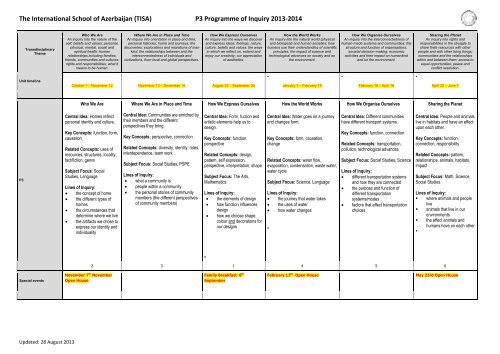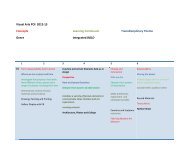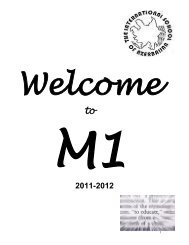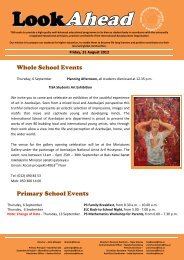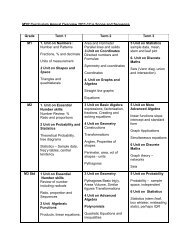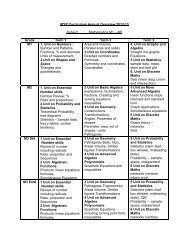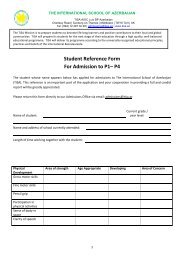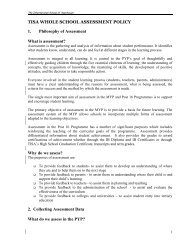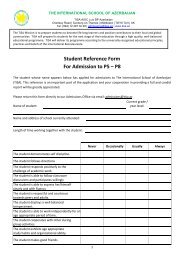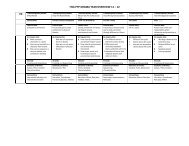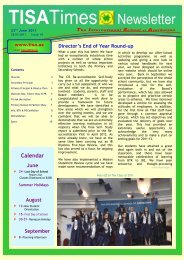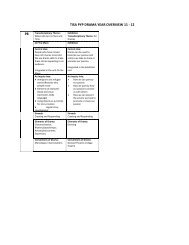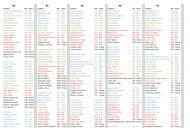The International School of Azerbaijan (TISA) P3 Programme of Inquiry 2013-2014
P3 Year Overview 2013-14 - The International School of Azerbaijan
P3 Year Overview 2013-14 - The International School of Azerbaijan
You also want an ePaper? Increase the reach of your titles
YUMPU automatically turns print PDFs into web optimized ePapers that Google loves.
<strong>The</strong> <strong>International</strong> <strong>School</strong> <strong>of</strong> <strong>Azerbaijan</strong> (<strong>TISA</strong>) <strong>P3</strong> <strong>Programme</strong> <strong>of</strong> <strong>Inquiry</strong> <strong>2013</strong>-<strong>2014</strong><br />
Transdisciplinary<br />
<strong>The</strong>me<br />
Who We Are<br />
An inquiry into the nature <strong>of</strong> the<br />
self; beliefs and values; personal,<br />
physical, mental, social and<br />
spiritual health; human<br />
relationships including families,<br />
friends, communities and cultures;<br />
rights and responsibilities; what it<br />
means to be human.<br />
Where We Are in Place and Time<br />
An inquiry into orientation in place and time;<br />
personal histories; home and journeys; the<br />
discoveries; explorations and migrations <strong>of</strong> man<br />
kind; the relationships between and the<br />
interconnectedness <strong>of</strong> individuals and<br />
civilizations, from local and global perspectives.<br />
How We Express Ourselves<br />
An inquiry into the ways we discover<br />
and express ideas, feelings, nature,<br />
culture, beliefs and values; the ways<br />
in which we reflect on, extend and<br />
enjoy our creativity; our appreciation<br />
<strong>of</strong> aesthetics.<br />
How the World Works<br />
An inquiry into the natural world (physical<br />
and biological) and human societies; how<br />
humans use their understanding <strong>of</strong> scientific<br />
principles; the impact <strong>of</strong> science and<br />
technological advances on society and on<br />
the environment.<br />
How We Organise Ourselves<br />
An inquiry into the interconnectedness <strong>of</strong><br />
human-made systems and communities; the<br />
structure and function <strong>of</strong> organisations;<br />
societal decision-making; economic<br />
activities and their impact on humankind<br />
and on the environment.<br />
Sharing the Planet<br />
An inquiry into rights and<br />
responsibilities in the struggle to<br />
share finite resources with other<br />
people and with other living things;<br />
communities and the relationships<br />
within and between them; access to<br />
equal opportunities; peace and<br />
conflict resolution.<br />
Unit timeline<br />
• • •<br />
October 1 – November 12 November 13 – December 14 August 22 – September 30 January 7 – February 15 February 18 – April 19 April 22 – June 7<br />
Who We Are<br />
Where We Are in Place and Time<br />
How We Express Ourselves<br />
How the World Works<br />
How We Organise Ourselves<br />
Sharing the Planet<br />
<strong>P3</strong><br />
Central Idea: Homes reflect<br />
personal identity and culture.<br />
Key Concepts: function, form,<br />
causation<br />
Related Concepts: uses <strong>of</strong><br />
resources, structures, locality,<br />
fact/fiction, genre<br />
Subject Focus: Social<br />
Studies, Language<br />
Lines <strong>of</strong> <strong>Inquiry</strong>:<br />
the concept <strong>of</strong> home<br />
the different types <strong>of</strong><br />
homes<br />
the circumstances that<br />
determine where we live<br />
the artifacts we chose to<br />
express our identity and<br />
individuality<br />
Central Idea: Communities are enriched by<br />
their members and the different<br />
perspectives they bring.<br />
Key Concepts: perspective, connection<br />
Related Concepts: diversity, identity, roles,<br />
interdependence, team work<br />
Subject Focus: Social Studies, PSPE<br />
Lines <strong>of</strong> <strong>Inquiry</strong>:<br />
what a community is<br />
people within a community<br />
the personal stories <strong>of</strong> community<br />
members (the different perspectives<br />
<strong>of</strong> community members)<br />
Central Idea: Form, fuction and<br />
artistic elements help us to<br />
design.<br />
Key Concepts: function,<br />
perspective<br />
Related Concepts: design,<br />
pattern, self expression,<br />
perspective, interpretation, shape<br />
Subject Focus: <strong>The</strong> Arts,<br />
Mathematics<br />
Lines <strong>of</strong> <strong>Inquiry</strong>:<br />
the elements <strong>of</strong> design<br />
how function influences<br />
design<br />
how we choose shape,<br />
colour and decorations for<br />
our designs<br />
Central Idea: Water goes on a journey<br />
and changes form.<br />
Key Concepts: form, causation,<br />
change<br />
Related Concepts: water flow,<br />
evaporation, condensation, waste water,<br />
water cycle<br />
Subject Focus: Science, Language<br />
Lines <strong>of</strong> <strong>Inquiry</strong>:<br />
the journey that water takes<br />
the uses <strong>of</strong> water<br />
how water changes<br />
•<br />
Central Idea: Different communities<br />
have different transport systems.<br />
Key Concepts: function, connection<br />
Related Concepts: transportation,<br />
pollution, technological advances<br />
Subject Focus: Social Studies, Science<br />
Lines <strong>of</strong> <strong>Inquiry</strong>:<br />
different transportation systems<br />
and how they are connected<br />
the purpose and function <strong>of</strong><br />
different transportation<br />
systems/modes<br />
factors that affect transportation<br />
choices<br />
Central Idea: People and animals<br />
live in habitats and have an effect<br />
upon each other.<br />
Key Concepts: function,<br />
connection, responsibility<br />
Related Concepts: pattern,<br />
relationships, animals, habitats,<br />
impact<br />
Subject Focus: Math, Science,<br />
Social Studies<br />
Lines <strong>of</strong> <strong>Inquiry</strong>:<br />
• where animals and people<br />
live<br />
• animals that live in our<br />
environments<br />
• the effect animals and<br />
humans have on each other<br />
•<br />
•<br />
2 3 1 4 5 6<br />
Special events<br />
November 7 th November<br />
Open House<br />
Family Breakfast 6 th<br />
September<br />
February 13 th Open House May 23rd Open House<br />
Updated: 28 August <strong>2013</strong>
Libr ary<br />
<strong>The</strong> <strong>International</strong> <strong>School</strong> <strong>of</strong> <strong>Azerbaijan</strong> (<strong>TISA</strong>) <strong>P3</strong> <strong>Programme</strong> <strong>of</strong> <strong>Inquiry</strong> <strong>2013</strong>-<strong>2014</strong><br />
Transdisciplinary<br />
<strong>The</strong>me<br />
Library<br />
Who We Are<br />
An inquiry into the nature <strong>of</strong> the<br />
self; beliefs and values; personal,<br />
physical, mental, social and<br />
spiritual health; human<br />
relationships including families,<br />
friends, communities and cultures;<br />
rights and responsibilities; what it<br />
means to be human.<br />
Children listen to<br />
family, home stories,<br />
followed up by<br />
responses to the<br />
stories. Focus <strong>of</strong><br />
stories is working<br />
and playing together<br />
in the home.<br />
Responses include:<br />
drawing, writing,<br />
puppetry, drama.<br />
Focus on supporting<br />
attitudes and<br />
behaviors in the<br />
library (listening,<br />
following<br />
directions), library<br />
skills (recalling,<br />
retelling,<br />
representing).<br />
Where We Are in Place and Time<br />
An inquiry into orientation in place and time;<br />
personal histories; home and journeys; the<br />
discoveries; explorations and migrations <strong>of</strong> man<br />
kind; the relationships between and the<br />
interconnectedness <strong>of</strong> individuals and<br />
civilizations, from local and global perspectives.<br />
Children listen to stories to<br />
learn about jobs within an<br />
urban community. Children<br />
will be asked to recall details<br />
from the stories.<br />
Children will be provided with<br />
several information books<br />
about jobs (community<br />
helpers). <strong>The</strong>y will vote for<br />
one to have read aloud. After<br />
listening to the nonfiction<br />
narrative, they will be asked to<br />
recall details <strong>of</strong> the person’s<br />
role in the community.<br />
Focus on difference between<br />
fiction and nonfiction.<br />
How We Express Ourselves<br />
An inquiry into the ways we discover<br />
and express ideas, feelings, nature,<br />
culture, beliefs and values; the ways<br />
in which we reflect on, extend and<br />
enjoy our creativity; our appreciation<br />
<strong>of</strong> aesthetics.<br />
Introduction: Story<br />
about writing and<br />
creating books (Library<br />
Mouse by Daniel Kirk).<br />
Children study books –<br />
toy, movable, pop-up,<br />
textured – with special<br />
design features (pop<br />
ups, movable elements,<br />
flaps that open).<br />
Children will discuss<br />
and design as a group a<br />
bottle book, using a<br />
small plastic water<br />
bottle (link with their<br />
classroom study). <strong>The</strong>n<br />
they will try to design a<br />
bottle book themselves<br />
using a very simple<br />
nursery rhyme.<br />
Focus on nursery<br />
rhyme genre.<br />
How the World Works<br />
An inquiry into the natural world (physical<br />
and biological) and human societies; how<br />
humans use their understanding <strong>of</strong> scientific<br />
principles; the impact <strong>of</strong> science and<br />
technological advances on society and on<br />
the environment.<br />
Introduction: Journey <strong>of</strong><br />
water in No More Water in<br />
the Tub (Arnold). Could<br />
this journey really happen?<br />
Draw a scene.<br />
Read stories and nonfiction<br />
about water and the journey<br />
it takes. Draw a map or<br />
representation <strong>of</strong> the<br />
journey that the water takes.<br />
Focus on imaginary versus<br />
real/fiction and nonfiction.<br />
How We Organise Ourselves<br />
An inquiry into the interconnectedness <strong>of</strong><br />
human-made systems and communities; the<br />
structure and function <strong>of</strong> organisations;<br />
societal decision-making; economic<br />
activities and their impact on humankind<br />
and on the environment.<br />
Introduce with fiction and<br />
nonfiction about subways.<br />
Look at easy readers on the<br />
theme <strong>of</strong> transportation: Mr.<br />
Putter & Tabby series (Fly<br />
the Plane, Run the Race,<br />
Row the Boat, Take the<br />
Train); Scholastic Level 1<br />
Readers (Hello, Fire<br />
Truck!; Hello, Freight<br />
Train!: Hello, <strong>School</strong> Bus!);<br />
Level 2 Good Driving,<br />
Amelia Bedelia. Segue into<br />
a stand-alone about easy<br />
reader. Discuss easy readers<br />
and easy reader chapter<br />
books; series; authors;<br />
illustrators). Compare easy<br />
reader levels.<br />
Focus: Learning about the<br />
world from fiction and<br />
nonfiction. Locating easy<br />
readers. Understanding the<br />
purpose <strong>of</strong> easy readers as<br />
a genre. What is a series?<br />
What is a reading level?<br />
Sharing the Planet<br />
An inquiry into rights and<br />
responsibilities in the struggle to<br />
share finite resources with other<br />
people and with other living things;<br />
communities and the relationships<br />
within and between them; access to<br />
equal opportunities; peace and<br />
conflict resolution.<br />
Introduction: <strong>The</strong> Best<br />
Seat in Second Grade<br />
by Katharine Kenah –<br />
name the animals in the<br />
story. Which are pets,<br />
wild, or farm? Zoo by<br />
Anthony Browne.<br />
Where do the animals<br />
live when they are in<br />
the wild?<br />
Viewing visuals from<br />
fiction and non-fiction<br />
narratives: only people,<br />
only animals, animals<br />
and people. Where are<br />
the animals – in homes,<br />
zoos, or the wild?<br />
Read fiction about pets,<br />
farm animals and<br />
domestic animals to<br />
compare different ways<br />
<strong>of</strong> treating animals.<br />
Animal rescue /<br />
relationship stories, in<br />
fiction and nonfiction<br />
formats.<br />
Activities and further<br />
info<br />
Updated: 28 August <strong>2013</strong>
<strong>The</strong> <strong>International</strong> <strong>School</strong> <strong>of</strong> <strong>Azerbaijan</strong> (<strong>TISA</strong>) <strong>P3</strong> <strong>Programme</strong> <strong>of</strong> <strong>Inquiry</strong> <strong>2013</strong>-<strong>2014</strong><br />
Transdisciplinary<br />
<strong>The</strong>me<br />
Who We Are<br />
An inquiry into the nature <strong>of</strong> the<br />
self; beliefs and values; personal,<br />
physical, mental, social and<br />
spiritual health; human<br />
relationships including families,<br />
friends, communities and cultures;<br />
rights and responsibilities; what it<br />
means to be human.<br />
Where We Are in Place and Time<br />
An inquiry into orientation in place and time;<br />
personal histories; home and journeys; the<br />
discoveries; explorations and migrations <strong>of</strong> man<br />
kind; the relationships between and the<br />
interconnectedness <strong>of</strong> individuals and<br />
civilizations, from local and global perspectives.<br />
How We Express Ourselves<br />
An inquiry into the ways we discover<br />
and express ideas, feelings, nature,<br />
culture, beliefs and values; the ways<br />
in which we reflect on, extend and<br />
enjoy our creativity; our appreciation<br />
<strong>of</strong> aesthetics.<br />
How the World Works<br />
An inquiry into the natural world (physical<br />
and biological) and human societies; how<br />
humans use their understanding <strong>of</strong> scientific<br />
principles; the impact <strong>of</strong> science and<br />
technological advances on society and on<br />
the environment.<br />
How We Organise Ourselves<br />
An inquiry into the interconnectedness <strong>of</strong><br />
human-made systems and communities; the<br />
structure and function <strong>of</strong> organisations;<br />
societal decision-making; economic<br />
activities and their impact on humankind<br />
and on the environment.<br />
Sharing the Planet<br />
An inquiry into rights and<br />
responsibilities in the struggle to<br />
share finite resources with other<br />
people and with other living things;<br />
communities and the relationships<br />
within and between them; access to<br />
equal opportunities; peace and<br />
conflict resolution.<br />
Focus: Easy readers<br />
and what the Level 2<br />
mean. Learning about<br />
the world from fiction<br />
and nonfiction. What<br />
are true stories?<br />
Maths:<br />
integrated in unit<br />
Data Handling<br />
Constructing<br />
Understand that sets<br />
can be organised by<br />
different attributes<br />
Transferring<br />
Represent information<br />
through pictographs and<br />
tally marks<br />
Applying<br />
Apply and create<br />
pictographs and tally<br />
marks<br />
Pattern and Function<br />
Measurement<br />
Measure arbitary unit<br />
Map making<br />
Time – today tomorrow, soon,<br />
later,<br />
Data handling<br />
Shape and Space<br />
Constructing:<br />
Understand that there are<br />
relationships among and<br />
between 2D and 3D<br />
shapes<br />
Understand that 2D and<br />
3D shapes can be created<br />
by putting together and/or<br />
taking apart other shapes<br />
Understand that geometric<br />
shapes are useful for<br />
representing real world<br />
situations<br />
Transferring:<br />
Analyse and describe the<br />
relationships between 2D<br />
and 3D shapes<br />
Represent ideas about the<br />
real world using geometric<br />
vocabulary and symbols<br />
Applying:<br />
Analyse and use what they<br />
know about 3D shapes to<br />
describe and work with 2D<br />
Measurement<br />
Capacity<br />
Data handling<br />
Probability<br />
Estimation<br />
Measurement<br />
Constructing:<br />
understand that attributes can<br />
be compared and described<br />
Understand the use <strong>of</strong> standard<br />
units to measure<br />
Understand that tools can be<br />
used to measure<br />
Transferring:<br />
identify, compare and describe<br />
attributes <strong>of</strong> real objects<br />
Estimate and measure objects<br />
using standard units <strong>of</strong><br />
measurement<br />
Applying:<br />
Describe observations about<br />
events and objects in real life<br />
situations<br />
Use non-standard units <strong>of</strong><br />
measurement to solve problems<br />
in real life situations involving<br />
length and mass<br />
Shape and Space<br />
Pattern/Function<br />
Constructing: Understand<br />
that patterns can be found<br />
in everyday situations e.g.<br />
nature<br />
Transferring: Represent<br />
patterns in a variety <strong>of</strong><br />
ways<br />
Applying: Extend and<br />
create patterns<br />
Shape and Space<br />
Constructing:<br />
Understand that examples<br />
<strong>of</strong> symmetry and<br />
transformations can be<br />
found in their immediate<br />
environment<br />
Transferring:<br />
Identify lines <strong>of</strong> reflective<br />
symmetry<br />
Applying:<br />
Recognise and explain<br />
simple symmetrical<br />
designs in the environment<br />
Updated: 28 August <strong>2013</strong>
<strong>The</strong> <strong>International</strong> <strong>School</strong> <strong>of</strong> <strong>Azerbaijan</strong> (<strong>TISA</strong>) <strong>P3</strong> <strong>Programme</strong> <strong>of</strong> <strong>Inquiry</strong> <strong>2013</strong>-<strong>2014</strong><br />
Transdisciplinary<br />
<strong>The</strong>me<br />
Who We Are<br />
An inquiry into the nature <strong>of</strong> the<br />
self; beliefs and values; personal,<br />
physical, mental, social and<br />
spiritual health; human<br />
relationships including families,<br />
friends, communities and cultures;<br />
rights and responsibilities; what it<br />
means to be human.<br />
Where We Are in Place and Time<br />
An inquiry into orientation in place and time;<br />
personal histories; home and journeys; the<br />
discoveries; explorations and migrations <strong>of</strong> man<br />
kind; the relationships between and the<br />
interconnectedness <strong>of</strong> individuals and<br />
civilizations, from local and global perspectives.<br />
How We Express Ourselves<br />
An inquiry into the ways we discover<br />
and express ideas, feelings, nature,<br />
culture, beliefs and values; the ways<br />
in which we reflect on, extend and<br />
enjoy our creativity; our appreciation<br />
<strong>of</strong> aesthetics.<br />
How the World Works<br />
An inquiry into the natural world (physical<br />
and biological) and human societies; how<br />
humans use their understanding <strong>of</strong> scientific<br />
principles; the impact <strong>of</strong> science and<br />
technological advances on society and on<br />
the environment.<br />
How We Organise Ourselves<br />
An inquiry into the interconnectedness <strong>of</strong><br />
human-made systems and communities; the<br />
structure and function <strong>of</strong> organisations;<br />
societal decision-making; economic<br />
activities and their impact on humankind<br />
and on the environment.<br />
Sharing the Planet<br />
An inquiry into rights and<br />
responsibilities in the struggle to<br />
share finite resources with other<br />
people and with other living things;<br />
communities and the relationships<br />
within and between them; access to<br />
equal opportunities; peace and<br />
conflict resolution.<br />
shapes<br />
Constructing:<br />
Understand that geometric<br />
shapes are useful for<br />
representing real world<br />
situations<br />
Understand the directions can<br />
be used to describe pathways,<br />
regions, positions and<br />
boundaries <strong>of</strong> their immediate<br />
environment<br />
Transferring:<br />
Describe position and direction<br />
Applying:<br />
Explore and describe paths,<br />
regions, positions and<br />
boundaries <strong>of</strong> their immediate<br />
environment<br />
Updated: 28 August <strong>2013</strong>
<strong>The</strong> <strong>International</strong> <strong>School</strong> <strong>of</strong> <strong>Azerbaijan</strong> (<strong>TISA</strong>) <strong>P3</strong> <strong>Programme</strong> <strong>of</strong> <strong>Inquiry</strong> <strong>2013</strong>-<strong>2014</strong><br />
Transdisciplinary<br />
<strong>The</strong>me<br />
Maths:<br />
stand<br />
alone<br />
IT<br />
Who We Are<br />
An inquiry into the nature <strong>of</strong> the<br />
self; beliefs and values; personal,<br />
physical, mental, social and<br />
spiritual health; human<br />
relationships including families,<br />
friends, communities and cultures;<br />
rights and responsibilities; what it<br />
means to be human.<br />
Numbers<br />
Revise counting and ordering to 20<br />
Counting to 20 with accuracy<br />
Read write and order numbers to 30.<br />
Where We Are in Place and Time<br />
An inquiry into orientation in place and time;<br />
personal histories; home and journeys; the<br />
discoveries; explorations and migrations <strong>of</strong> man<br />
kind; the relationships between and the<br />
interconnectedness <strong>of</strong> individuals and<br />
civilizations, from local and global perspectives.<br />
Compare numbers to 30 and say which is less or more<br />
Continue a count forwards or backwards from a given number<br />
Odd and even numbers<br />
Introduce numbers more than 20<br />
Shapes<br />
How We Express Ourselves<br />
An inquiry into the ways we discover<br />
and express ideas, feelings, nature,<br />
culture, beliefs and values; the ways<br />
in which we reflect on, extend and<br />
enjoy our creativity; our appreciation<br />
<strong>of</strong> aesthetics.<br />
Identify regular 2D shapes eg circle triangles square and rectangle and describe their<br />
properties<br />
Understand that some 3D shapes have 2D faces<br />
Sorting, Matching and Patterns<br />
Sort objects according to attributes such as size and shape<br />
Talk about, recognize and create patterns that exist in or on real objects.<br />
Make predictions from simple patterns<br />
Design applications. Use <strong>of</strong><br />
ipad to explain their ideas<br />
Use <strong>of</strong> apps to support<br />
language and<br />
mathematics. Use QR<br />
codes to access unit<br />
youtubes and relevant<br />
sites.<br />
Take pictures <strong>of</strong> various members <strong>of</strong><br />
staff as they go about their work and<br />
provide captions.<br />
Use <strong>of</strong> apps to support language and<br />
mathematics.<br />
Use QR codes to access unit youtubes<br />
and relevant sites.<br />
Introduce Ipads<br />
Use the following<br />
programmes to make and<br />
explore design: Art Lab,<br />
Pattern Tool HD, Design<br />
Museum<br />
Use <strong>of</strong> apps to support<br />
language and mathematics<br />
How the World Works<br />
An inquiry into the natural world (physical<br />
and biological) and human societies; how<br />
humans use their understanding <strong>of</strong> scientific<br />
principles; the impact <strong>of</strong> science and<br />
technological advances on society and on<br />
the environment.<br />
How We Organise Ourselves<br />
An inquiry into the interconnectedness <strong>of</strong><br />
human-made systems and communities; the<br />
structure and function <strong>of</strong> organisations;<br />
societal decision-making; economic<br />
activities and their impact on humankind<br />
and on the environment.<br />
Simple addition and subtraction<br />
Understand the operation <strong>of</strong> addition and subtraction<br />
Solve simple problems or puzzles and make simple estimates and predictions<br />
Begin to use + - and = signs to record mental calculations<br />
Language more/less/equal with numbers in pictograph<br />
Uses the knowledge that addition is commutative<br />
Understand that subtraction is also difference<br />
Use the = sign to represent equality<br />
Sharing the Planet<br />
An inquiry into rights and<br />
responsibilities in the struggle to<br />
share finite resources with other<br />
people and with other living things;<br />
communities and the relationships<br />
within and between them; access to<br />
equal opportunities; peace and<br />
conflict resolution.<br />
Recognize that more than 2 numbers can be added together<br />
Know addition and subtraction facts for all pairs <strong>of</strong> numbers with a total <strong>of</strong> at least 5<br />
Use numbers facts to add and subtract mentally<br />
Recognize a symbol to represent an unknown number<br />
Use fraction names half, fourth, and quarter to describe part and whole relationships<br />
Odd and even numbers<br />
Introduce place value<br />
Numbers 1-50<br />
Begin to use + - and = signs to record calculations<br />
Use <strong>of</strong> apps to support language and<br />
mathematics<br />
Use QR codes to access unit<br />
youtubes and relevant sites.<br />
Use <strong>of</strong> apps to record their<br />
findings.<br />
Use <strong>of</strong> apps to support language<br />
and mathematics. Use <strong>of</strong> apps<br />
to record their findings.<br />
Use QR codes to access unit<br />
youtubes and relevant sites.<br />
Use ipads to collect and<br />
record data about animals<br />
around the school campus.<br />
Collect students opinions and<br />
information like favourite<br />
pets<br />
Online activities on<br />
camouflage on walking with<br />
the beasts website.<br />
Updated: 28 August <strong>2013</strong>
<strong>The</strong> <strong>International</strong> <strong>School</strong> <strong>of</strong> <strong>Azerbaijan</strong> (<strong>TISA</strong>) <strong>P3</strong> <strong>Programme</strong> <strong>of</strong> <strong>Inquiry</strong> <strong>2013</strong>-<strong>2014</strong><br />
Transdisciplinary<br />
<strong>The</strong>me<br />
Visual Arts<br />
PE<br />
Who We Are<br />
An inquiry into the nature <strong>of</strong> the<br />
self; beliefs and values; personal,<br />
physical, mental, social and<br />
spiritual health; human<br />
relationships including families,<br />
friends, communities and cultures;<br />
rights and responsibilities; what it<br />
means to be human.<br />
Central Idea:<br />
Homes reflect personal<br />
identity and culture<br />
Concepts: Form<br />
An <strong>Inquiry</strong> into:<br />
the concept <strong>of</strong> home<br />
and room<br />
the decoration <strong>of</strong><br />
homes, materials<br />
and furniture<br />
homes in different<br />
locations and<br />
cultures<br />
Artistic elements:<br />
Form, shape, materials<br />
Genres:<br />
Diorama<br />
(Fully intergrated)<br />
Cooperative Games<br />
Central Idea:<br />
Each game has an aim<br />
and rules.<br />
An <strong>Inquiry</strong> into:<br />
A variety <strong>of</strong> games<br />
<strong>The</strong> aims <strong>of</strong> a game<br />
<strong>The</strong> rules <strong>of</strong> a game<br />
<strong>The</strong> responsibilities<br />
within a game<br />
Where We Are in Place and Time<br />
An inquiry into orientation in place and time;<br />
personal histories; home and journeys; the<br />
discoveries; explorations and migrations <strong>of</strong> man<br />
kind; the relationships between and the<br />
interconnectedness <strong>of</strong> individuals and<br />
civilizations, from local and global perspectives.<br />
Central idea:<br />
Communities are enriched by<br />
their members and the different<br />
perspectives they bring<br />
Concepts: Responsibility<br />
An inquiry into:<br />
what is a community<br />
the personal story or<br />
perspective <strong>of</strong> community<br />
members<br />
making a mural as a community<br />
Artistic elements:<br />
Colour, line, perspective<br />
Genres:<br />
Mural<br />
(intergrated)<br />
Ball Games and skills<br />
(Introduction to Football)<br />
Central Idea:<br />
<strong>The</strong>re are different ways to<br />
throw, catch and kick a ball.<br />
An <strong>Inquiry</strong> into:<br />
how to kick a ball<br />
how to trap a ball<br />
how to pass a ball<br />
how to control a ball<br />
goalkeepers skills<br />
How We Express Ourselves<br />
An inquiry into the ways we discover<br />
and express ideas, feelings, nature,<br />
culture, beliefs and values; the ways<br />
in which we reflect on, extend and<br />
enjoy our creativity; our appreciation<br />
<strong>of</strong> aesthetics.<br />
Central idea:<br />
Function and artistic<br />
elements help us to<br />
design.<br />
Concepts: Perspective<br />
An inquiry into:<br />
Designing new art from<br />
functional objects.<br />
Perspective and shape<br />
Self expression<br />
Pattern and decoration<br />
Artistic elements:<br />
Line, shape, form, texture<br />
Genres:<br />
Recycled art<br />
(Fully intergrated)<br />
Introduction to<br />
Gymnastics<br />
Central Idea:<br />
We can make patterns in<br />
our movements.<br />
An <strong>Inquiry</strong> into:<br />
What gymnastics is<br />
Different balances,<br />
rolls and jumps<br />
Working in a way that<br />
is safe for ourselves<br />
and others<br />
Combining elements<br />
into sequences<br />
How the World Works<br />
An inquiry into the natural world (physical<br />
and biological) and human societies; how<br />
humans use their understanding <strong>of</strong> scientific<br />
principles; the impact <strong>of</strong> science and<br />
technological advances on society and on<br />
the environment.<br />
Central idea:<br />
We can use illustrations to<br />
represent different forms <strong>of</strong><br />
water in the water cycle.<br />
Concepts: Causation<br />
An inquiry into:<br />
the different forms <strong>of</strong> water in<br />
storybooks<br />
different techniques to<br />
illustrate water<br />
different shapes, stages <strong>of</strong> water<br />
Artistic elements:<br />
Line, colour, materials<br />
Genres:<br />
Paintings, drawings<br />
(intergrated)<br />
Ball Games and skills<br />
(Introduction to Basketball<br />
and Hockey)<br />
Central Idea:<br />
<strong>The</strong>re are different ways to<br />
throw, catch and kick a ball.<br />
(Continued)<br />
An <strong>Inquiry</strong> into:<br />
how to throw/shoot a ball<br />
how to catch a ball<br />
how to dribble a ball<br />
how to pass a ball<br />
how to hit a ball<br />
how to control a ball<br />
goalkeepers skills<br />
(Continued)<br />
How We Organise Ourselves<br />
An inquiry into the interconnectedness <strong>of</strong><br />
human-made systems and communities; the<br />
structure and function <strong>of</strong> organisations;<br />
societal decision-making; economic<br />
activities and their impact on humankind<br />
and on the environment.<br />
Central Idea:<br />
Different communities have<br />
different transport systems.<br />
Concepts: connection<br />
Lines <strong>of</strong> <strong>Inquiry</strong>:<br />
• Different transportation<br />
systems and how they are<br />
connected<br />
• <strong>The</strong> purpose and function<br />
<strong>of</strong> different transportation<br />
systems/modes<br />
Factors that affect<br />
transportation choices<br />
Artistic elements:<br />
Designing and creating 3D<br />
objects.<br />
Genres:<br />
3D map<br />
(intergrated)<br />
Introduction to Fitness<br />
Central Idea:<br />
We can improve our fitness.<br />
An <strong>Inquiry</strong> into:<br />
<br />
<br />
<br />
What fitness is<br />
How we can improve our<br />
fitness<br />
Changes to our body when<br />
we do fitness activities<br />
Integration with the Unit <strong>of</strong><br />
<strong>Inquiry</strong> “ Sharing the Planet”<br />
Students will explore different<br />
ways <strong>of</strong> animals’ travelling<br />
around the world: jump like a<br />
bunny, hop like a kangaroo,<br />
gallop like an antelope, sprint<br />
<br />
Sharing the Planet<br />
An inquiry into rights and<br />
responsibilities in the struggle to<br />
share finite resources with other<br />
people and with other living things;<br />
communities and the relationships<br />
within and between them; access to<br />
equal opportunities; peace and<br />
conflict resolution.<br />
Central Idea:<br />
People and animals live in<br />
habitats and have an<br />
effect upon each other<br />
Concepts: connection<br />
and function<br />
An inquiry into:<br />
the shapes <strong>of</strong> the head<br />
and the body <strong>of</strong><br />
animals<br />
the colours <strong>of</strong> nature<br />
the patterns and<br />
texture <strong>of</strong> animals<br />
Artistic elements:<br />
Colour, texture, space,<br />
patterns<br />
Genres:<br />
Nature, Paintings<br />
Observational Drawings<br />
(intergrated concept)<br />
Introduction to Athletics<br />
Central Idea:<br />
In athletics we learn how<br />
to use our arms and legs<br />
effectively.<br />
An <strong>Inquiry</strong> into:<br />
Athletics disciplines<br />
<strong>The</strong> basic techniques <strong>of</strong><br />
each discipline<br />
Preparing for an event<br />
and finishing an event<br />
Body awareness and<br />
body control<br />
Practicing Sports day<br />
events<br />
Updated: 28 August <strong>2013</strong>
<strong>The</strong> <strong>International</strong> <strong>School</strong> <strong>of</strong> <strong>Azerbaijan</strong> (<strong>TISA</strong>) <strong>P3</strong> <strong>Programme</strong> <strong>of</strong> <strong>Inquiry</strong> <strong>2013</strong>-<strong>2014</strong><br />
Transdisciplinary<br />
<strong>The</strong>me<br />
Who We Are<br />
An inquiry into the nature <strong>of</strong> the<br />
self; beliefs and values; personal,<br />
physical, mental, social and<br />
spiritual health; human<br />
relationships including families,<br />
friends, communities and cultures;<br />
rights and responsibilities; what it<br />
means to be human.<br />
Where We Are in Place and Time<br />
An inquiry into orientation in place and time;<br />
personal histories; home and journeys; the<br />
discoveries; explorations and migrations <strong>of</strong> man<br />
kind; the relationships between and the<br />
interconnectedness <strong>of</strong> individuals and<br />
civilizations, from local and global perspectives.<br />
How We Express Ourselves<br />
An inquiry into the ways we discover<br />
and express ideas, feelings, nature,<br />
culture, beliefs and values; the ways<br />
in which we reflect on, extend and<br />
enjoy our creativity; our appreciation<br />
<strong>of</strong> aesthetics.<br />
How the World Works<br />
An inquiry into the natural world (physical<br />
and biological) and human societies; how<br />
humans use their understanding <strong>of</strong> scientific<br />
principles; the impact <strong>of</strong> science and<br />
technological advances on society and on<br />
the environment.<br />
How We Organise Ourselves<br />
An inquiry into the interconnectedness <strong>of</strong><br />
human-made systems and communities; the<br />
structure and function <strong>of</strong> organisations;<br />
societal decision-making; economic<br />
activities and their impact on humankind<br />
and on the environment.<br />
Sharing the Planet<br />
An inquiry into rights and<br />
responsibilities in the struggle to<br />
share finite resources with other<br />
people and with other living things;<br />
communities and the relationships<br />
within and between them; access to<br />
equal opportunities; peace and<br />
conflict resolution.<br />
like a cheetah, jump like a frog,<br />
walk like a goose, etc.<br />
Performing<br />
Arts<br />
Unit Title: Routine and rhythm<br />
Central Idea:<br />
We establish routines to work as a group.<br />
An <strong>Inquiry</strong> into:<br />
• Learning as a group<br />
• Routines in drama<br />
• Working as a group<br />
Unit Title: Movement and music<br />
Central Idea:<br />
We experience music first through<br />
movement, then through instruments.<br />
An <strong>Inquiry</strong> into:<br />
• how we can move to music<br />
• using the voice and body to create musical<br />
patterns<br />
• transferring body percussion to<br />
instruments<br />
• play unturned percussion instruments in<br />
time with a beat<br />
Unit title:<br />
Drama<br />
Central Idea<br />
We can<br />
characterize<br />
the figures <strong>of</strong><br />
a story.<br />
An <strong>Inquiry</strong><br />
into:<br />
using our<br />
bodies to<br />
become<br />
characters<br />
using our<br />
voices to<br />
support a<br />
story<br />
using our<br />
voices to<br />
support a<br />
character<br />
Central Idea: People and<br />
animals live in habitats and<br />
have an effect upon each<br />
other<br />
An inquiry into:<br />
• Where animals and<br />
people live<br />
• <strong>The</strong> difference between<br />
people and animals.<br />
• How nature is one<br />
interconnected system<br />
Artistic mediums<br />
Characterisation <strong>of</strong><br />
different animals<br />
Role play <strong>of</strong> sharing and<br />
conflict scenarios<br />
Choir – group song<br />
Percussive<br />
accompaniment<br />
Creating forms to express<br />
ideas<br />
Host<br />
Country<br />
What “tastes” and<br />
“smells” are unique to<br />
<strong>Azerbaijan</strong>.<br />
Guest speakers: blind<br />
people (children and<br />
adults).<br />
Fieldtrip to dog training<br />
centre.<br />
Packaging and preserving<br />
techniques <strong>of</strong> <strong>Azerbaijan</strong>.<br />
Compare local diet to other<br />
cultures.<br />
Learn about the meaning<br />
behind the local<br />
celebrations: Novruz,<br />
Woman’s Day, and<br />
Independence Day.<br />
Study and<br />
experiments in<br />
weather in<br />
<strong>Azerbaijan</strong>.<br />
Study and visit Gobustan. the life and<br />
culture there before. Study buildings and<br />
excavations <strong>of</strong> the Old City.<br />
Look at <strong>Azerbaijan</strong><br />
carpets at the Museum.<br />
Look at Natural color and<br />
dyes <strong>of</strong> <strong>Azerbaijan</strong><br />
carpets.<br />
Updated: 28 August <strong>2013</strong>
<strong>The</strong> <strong>International</strong> <strong>School</strong> <strong>of</strong> <strong>Azerbaijan</strong> (<strong>TISA</strong>) <strong>P3</strong> <strong>Programme</strong> <strong>of</strong> <strong>Inquiry</strong> <strong>2013</strong>-<strong>2014</strong><br />
Transdisciplinary<br />
<strong>The</strong>me<br />
Who We Are<br />
An inquiry into the nature <strong>of</strong> the<br />
self; beliefs and values; personal,<br />
physical, mental, social and<br />
spiritual health; human<br />
relationships including families,<br />
friends, communities and cultures;<br />
rights and responsibilities; what it<br />
means to be human.<br />
Where We Are in Place and Time<br />
An inquiry into orientation in place and time;<br />
personal histories; home and journeys; the<br />
discoveries; explorations and migrations <strong>of</strong> man<br />
kind; the relationships between and the<br />
interconnectedness <strong>of</strong> individuals and<br />
civilizations, from local and global perspectives.<br />
How We Express Ourselves<br />
An inquiry into the ways we discover<br />
and express ideas, feelings, nature,<br />
culture, beliefs and values; the ways<br />
in which we reflect on, extend and<br />
enjoy our creativity; our appreciation<br />
<strong>of</strong> aesthetics.<br />
How the World Works<br />
An inquiry into the natural world (physical<br />
and biological) and human societies; how<br />
humans use their understanding <strong>of</strong> scientific<br />
principles; the impact <strong>of</strong> science and<br />
technological advances on society and on<br />
the environment.<br />
How We Organise Ourselves<br />
An inquiry into the interconnectedness <strong>of</strong><br />
human-made systems and communities; the<br />
structure and function <strong>of</strong> organisations;<br />
societal decision-making; economic<br />
activities and their impact on humankind<br />
and on the environment.<br />
Sharing the Planet<br />
An inquiry into rights and<br />
responsibilities in the struggle to<br />
share finite resources with other<br />
people and with other living things;<br />
communities and the relationships<br />
within and between them; access to<br />
equal opportunities; peace and<br />
conflict resolution.<br />
Updated: 28 August <strong>2013</strong>


